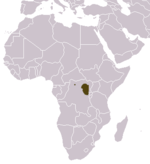Aquatic life
| Aquatic life | ||||||||||||
|---|---|---|---|---|---|---|---|---|---|---|---|---|

Water civette ( Genetta piscivora ) |
||||||||||||
| Systematics | ||||||||||||
|
||||||||||||
| Scientific name | ||||||||||||
| Genetta piscivora | ||||||||||||
| ( JA Allen , 1919) |
The aquatic civet ( Genetta piscivora ) is a species of predator from the family of the crawling cats (Viverridae). She is one of the rarest and least known representatives of her family.
features
The water civette is one of the few crawling cats whose fur is not provided with stripes or spots. It is rusty brown in color, with the ears, legs and long tail being darker, dark brown or black. They have white spots between the eyes and on the side of the snout. Your body is elongated and your limbs are relatively short. In contrast to the closely related genet cats , the soles are hairless, an adaptation to the water-dwelling way of life. The head body length is around 45 centimeters, plus a tail that is around 35 centimeters long. Their weight is around 1.5 kilograms.
Occurrence and habitat
So far, occurrences of the aquatic species are only known along rivers in the northeast of the Democratic Republic of the Congo ; there are also unconfirmed sightings from Uganda and Burundi . It lives in tropical rainforests between 500 and 1500 meters above sea level.
Way of life
Very little is known about the way these animals live. They lead a semi-aquatic (partially in the water) way of life and are likely to be nocturnal loners. Their diet consists mainly of fish and frogs , sometimes they also eat cassava tubers soaked in water .
status
The degree of risk to aquatic species is also unknown. However, they are considered to be quite common in certain areas, especially since their area of distribution is relatively sparsely populated.
Systematics
The taxonomic position of this species has changed over time. While earlier authors put them in the independent genus Osbornictis , it is classified in current classifications (e.g. Mammal Species of the World , 2005) in the genus of genets.
Individual evidence
- ↑ Don E. Wilson, DeAnn M. Reeder (Eds.): Mammal Species of the World: A Taxonomic and Geographic Reference (3rd edition) ( Memento June 4, 2010 on the Internet Archive ) . Johns Hopkins University Press, 2005.
literature
- Ronald M. Nowak: Walker's Mammals of the World . Johns Hopkins University Press, 1999 ISBN 0801857899
Web links
- Illustration
- Genetta piscivora inthe IUCN 2013 Red List of Threatened Species . Posted by: Van Rompaey, H., Gaubert, P. & Hoffmann, M., 2008. Retrieved September 7, 2013.
